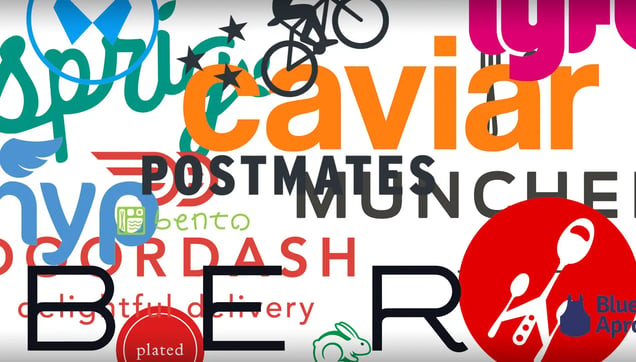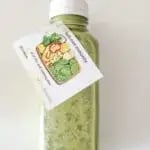You see them all the time: refer a friend and get $20 off your next meal when they sign up. Get discounts each time someone uses your code. Share on Facebook and we’ll give you a coconut oil shiatsu rubdown while reciting the 50 states.

Since everyone and their parent company seem to do it, I guess it must get them new customers with a positive ROI. Good for them. Right?
Here’s my question: does this shit actually work or is this all part of the overhyped bubble that Vanity Fair wrote about last week?
Who’s footing the bill? Do customers actually stick around or are most of them one and done?
I wanted to learn a bit more so I came up with the only plan that made sense: make fake profiles for a bunch of services, refer myself to get double the money, and unabashedly order free food to try and feed the office for a week.
It was fun while it lasted but, as you’ll see, there’s a hidden cost that even we couldn’t afford to pay.
Once upon a time…
This story starts with an Argentinian roommate who lived in my San Francisco basement a few summers ago.
He was a man of interesting habits which included but were certainly not limited to drenching himself with Axe, taping ziplock bags of vodka to his leg to avoid paying for drinks at clubs, and working the referral system of a payment startup, GoPago, like nobody’s business.
At the time GoPago was offering a generous promotion — $25 for the referrer and referred. Pretty typical for a payments company trying to grow quickly. Paypal did the same back when Pets.com was still slinging dog food with a sock puppet.
My Argentinian friend would sit in his windowless basement cave armed with a spreadsheet to keep his multiple personalities in order and a network of Android emulators to refer himself to himself until he had enough cash for dinner.
It was unethical, but it worked really, really well. Twice a week he’d volunteer to order dinner for the whole house (we lived in a 5-bedroom place). We got burritos, monster trays of sushi, mediterranean, you name it.
His misguided resourcefulness and the fact that he didn’t get caught inspired the first part of our little experiment. Can you still eat for free on auto-referrals and get away with it?
Questionable place to start? Obviously. Here’s how it went.
The master plan
The first step in the experiment required setting up a network of aliases.
Finding fake names is easy; I decided to use a random name generator and pick 30 that sounded like real people. What sounds like a real person? Randal Beecher or Wilson Stelter. What doesn’t sound like a real name? Cornelius Buchanan (pictured below).

Next, I needed some targets. San Francisco natives will recognize most, if not all of this list: SpoonRocket, Sprig, Bento, Uber, Munchery, DoorDash, Caviar… These are the usual suspects whose minions run wildly through the streets, fully branded and determined to deliver.
I personally hadn’t used any of these services with the exception of Uber so I was excited to see what all the fuss was about.

Fake names, check. Targets, check. Next came the tough part.
Taking a page from my Argentinian roommate’s playbook, I downloaded the free Android emulator (Xamarin Android Player), created a new Google Play account, and downloaded the apps. To avoid potential spam detection, I used two tools, Burner and Blur. Yeah, I know… even the names sound sketchy as hell.
That said, Burner is awesome. They’re a 500 Startups grad who made an app that masks phone numbers. It’s easy to use and perfect for selling drugs or ordering dishonest smoothies.
Blur has a similar function but masks email addresses and credit cards rather than phone numbers. I have no clue when and how this is used for legitimate purposes but it works. One credit card, one email address, one phone number, infinite combinations.
So it begins
The stage was set. I had an army of fake people, unique credit cards, phone numbers, email addresses, and Android phones. Time to get some free shit.
I was a little nervous so I started off small. SpoonRocket offers a $10 credit for referrals and, thankfully, my fake friend Robby Brink was looking for something cool and refreshing to drink.
I made a new account, used the promo code, opened up the app, and found a crisp, digital Thomas Jefferson begging to be spent. I ordered a LivBlends Fresh Mint Immunity Smoothie.
Ten minutes later a driver pulled up, handed me a smoothie, and threw in a complimentary It’s-It Ice Cream Sandwich as a customer appreciation deal. The smoothie was so-so. I rated it a 5/10 because of the texture. The ice cream sandwich was the perfect temperature and It’s-It sandwiches are awesome. 10/10.


So far, so good. Just got an afternoon pick-me-up for free and in under 10 minutes.
The next day I got a little more aggressive. Could I get lunch for three people?
SpoonRocket and Caviar, meet Erick Bahr, Doyle Quimby, and Patty Mayonnaise. This took a little bit more coordination but by lunchtime I had a sausage and bacon breakfast burrito, complimentary Blue Bottle New Orleans Iced Coffee, two taco platters (steak and baja with sweet potato fries), and an order of fish and chips from Pacific Catch. I paid a delivery fee for Caviar but it was under $5.
Life was great. I was cruising towards a bountiful week of free, on-demand meals courtesy of unnamed LPs. For the first time in my professional life, I was fueled by venture capital investments!
But then I stopped. Pulled the plug. Threw in the towel. Called it quits.
The realization
While merrily munching away, I felt an annoying sting in the back of my head.
Thankfully everyone else in the room felt the same way so the decision was easy and final. I wasn’t going to move forward with the experiment.
This test wasn’t uncovering a useful shortcut or a noteworthy entrepreneurial insight. This was straight up stealing. No different than shoplifting from Walgreens and writing about what kind of jacket has the best hidden pockets.
Yes, startups that offer free stuff to people who spread their gospel are asking to be taken advantage of, but I’d prefer to leave the downright dishonest crap to Amway.
I don’t want Sprig, Caviar, or SpoonRocket to spend their combined $85m investment cash on a lifetime supply of free chicken curry for word-of-mouth charlatans like me.
I want those companies to succeed! And I’d be a hypocritical assclown if I weren’t rooting for them from the sidelines while enjoying the fruits of their labor.
So why even publish this post?
Well, that’s a great question. At the risk of inspiring copycats, I wanted to remind everyone of a very obvious but sometimes forgotten value: no matter who or what it is, stealing is wrong.
It’s easy for us to get caught up in stories of interesting ways people cut corners and game the system but that’s only half of the story. Let’s not forget those who are trying to make an honest buck, one organic falafel wrap at a time.
We cool?
Good. Now, let’s go eat a goddamn snack.
